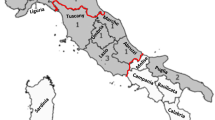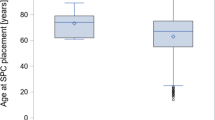Abstract
Study design:
Retrospective, comparative 4-year study.
Objectives:
To identify the clinical characteristics unique to older patients with spinal cord injury (SCI).
Setting:
Turkish Armed Forces Rehabilitation Center, Ankara, Turkey.
Methods:
The study included 870 consecutive patients with SCI that were divided into two groups according to age. Patients aged ⩾60 years at the time of injury constituted the study group, and randomly selected patients aged <60 years that were matched for gender, week of admission and time since injury constituted the control group. Patients’ demographic and clinical characteristics were recorded, compared and analyzed.
Results:
The study group included 73 SCI patients (mean age: 66.98±6.28 years) and the control group included 75 SCI patients (mean age: 33.93±10.67 years). Among the 148 patients, 98 (66.2%) were male. The vast majority of lesions were at the thoracic level (47.3%). In the older group, falls were the most frequent etiology (32.9%), simple falls predominated (62.5%). 49.3% of the study group vs 18.6% of the control group had a non-traumatic cause of SCI. Older patients were found to be less likely to have complete injury (27.4 vs 44%, P=0.035). The most common bladder management method was intermittent catheterization (69.6%) and the number of patients in each group treated with this method did not differ significantly (P>0.05). More patients in the study group had neuropathic pain (50.7 vs 34.7%, P=0.049) and abnormal urinary ultrasound findings (23.3 vs 9.3%, P=0.021).
Conclusion:
Results revealed that older patients with SCI may have different demographic and clinical features compared with younger patients.
Similar content being viewed by others
Log in or create a free account to read this content
Gain free access to this article, as well as selected content from this journal and more on nature.com
or
References
Furlan JC, Bracken MB, Fehlings MG . Is age a key determinant of mortality and neurological outcome after acute traumatic spinal cord injury? Neurobiol Aging 2010; 31: 434–446.
Pickett GE, Campos-Benitez M, Keller JL, Duggal N . Epidemiology of traumatic spinal cord injury in Canada. Spine (Phila Pa 1976) 2006; 31: 799–805.
Jabbour P, Fehlings M, Vaccaro AR, Harrop JS . Traumatic spine injuries in the geriatric population. Neurosurg Focus 2008; 25: E16.
Lenehan B, Street J, Kwon BK, Noonan V, Zhang H, Fisher CG et al. The epidemiology of traumatic spinal cord injury in British Columbia, Canada. Spine (Phila Pa 1976) 2012; 37: 321–329.
Dobriansky PJ, Suzman RM, Hodes RJ . Why Population Aging Matters: A Global Perspective. US Department of State, US Department of Health and Human Services, National Institute on Aging, National Institutes of Health: Washington, DC. 2007 pp 1–32.
Scivoletto G, Morganti B, Ditunno P, Ditunno JF, Molinari M . Effects on age on spinal cord lesion patients' rehabilitation. Spinal Cord 2003; 41: 457–464.
National Spinal Cord Injury Statistical Centre 2008 Annual Statistics Report, available at www.nscisc.uab.edu.
Tuğcu I, Tok F, Yılmaz B, Göktepe AS, Alaca R, Yazıcıoğlu K et al. Epidemiologic data of the patients with spinal cord injury: seven years' experience of a single center. Ulus Travma Acil Cerrahi Derg 2011; 17: 533–538.
Werhagen L, Hultling C, Molander C . The prevalence of neuropathic pain after non-traumatic spinal cord lesion. Spinal Cord 2007; 45: 609–615.
Rahimi-Movaghar V, Sayyah MK, Akbari H, Khorramirouz R, Rasouli MR, Moradi-Lakeh M et al. Epidemiology of traumatic spinal cord injury in developing countries: a systematic review. Neuroepidemiology 2013; 41: 65–85.
Quigley PA, Palacios P, Spehar AM . Veterans' fall risk profile: a prevalence study. Clin Interv Aging 2006; 1: 169–173.
Lee BB, Cripps RA, Fitzharris M, Wing PC . The global map for traumatic spinal cord injury epidemiology: update 2011, global incidence rate. Spinal Cord 2014; 52: 110–116.
Krassioukov AV, Furlan JC, Fehlings MG . Medical co-morbidities, secondary complications, and mortality in elderly with acute spinal cord injury. J Neurotrauma 2003; 20: 391–399.
Werhagen L, Budh CN, Hultling C, Molander C . Neuropathic pain after traumatic spinal cord injury—relations to gender, spinal level, completeness, and age at the time of injury. Spinal Cord 2004; 42: 665–673.
Chartier-Kastler E, Denys P . Intermittent catheterization with hydrophilic catheters as a treatment of chronic neurogenic urinary retention. Neurourol Urodyn 2011; 30: 21–31.
Cameron AP, Wallner LP, Tate DG, Sarma AV, Rodriguez GM, Clemens JQ . Bladder management after spinal cord injury in the United States 1972 to 2005. J Urol 2010; 184: 213–217.
Roth EJ, Lovell L, Heinemann AW, Lee MY, Yarkony GM . The older adult with a spinal cord injury. Paraplegia 1992; 30: 520–526.
Drake MJ, Cortina-Borja M, Savic G, Charlifue SW, Gardner BP . Prospective evaluation of urological effects of aging in chronic spinal cord injury by method of bladder management. Neurourol Urodyn 2005; 24: 111–116.
Acknowledgements
No funding, grants or equipment were provided for the project from any source. Nor were there financial benefits to the authors and it has not been published in any form of presentation previously.
Author information
Authors and Affiliations
Corresponding author
Ethics declarations
Competing interests
The authors declare no conflict of interest.
Rights and permissions
About this article
Cite this article
Güzelküçük, Ü., Demir, Y., Kesikburun, S. et al. Spinal cord injury in older population in Turkey. Spinal Cord 52, 850–854 (2014). https://doi.org/10.1038/sc.2014.103
Received:
Revised:
Accepted:
Published:
Issue date:
DOI: https://doi.org/10.1038/sc.2014.103
This article is cited by
-
Gait speed using powered robotic exoskeletons after spinal cord injury: a systematic review and correlational study
Journal of NeuroEngineering and Rehabilitation (2015)



